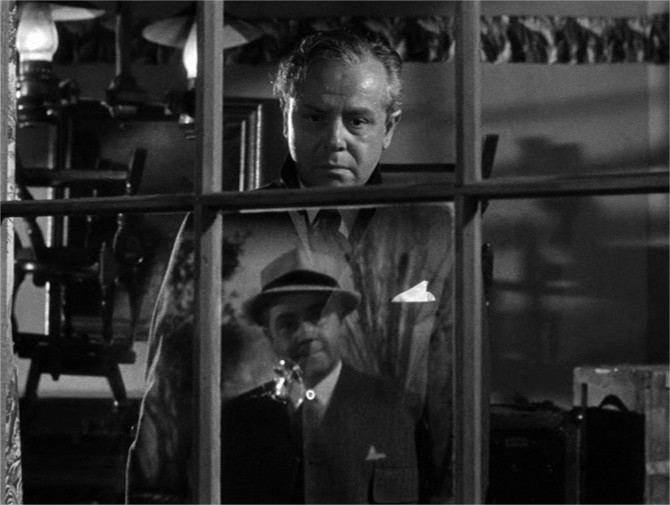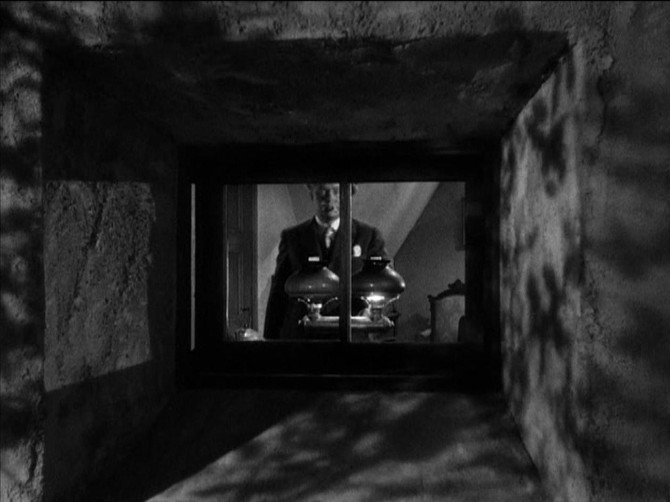“It is my belief, Watson, founded upon my experience, that the lowest and vilest alleys in London do not present a more dreadful record of sin than does the smiling and beautiful countryside” (Sherlock Holmes in “The Adventure of the Copper Beeches”)
An overtly cheerful vacation romp to the French countryside. . . until it isn’t, 1946’s So Dark the Night, directed by Joseph H. Lewis (Gun Crazy), transforms from unexpected romance to film noir murder mystery in the blink of an eye.
Following famous Parisian detective Henri Cassin (Steven Geray), the man is finally getting his long awaited vacation. Though those within the station talk about his recent stress level, the portly, closing-in-on-retirement detective seems in very good spirits.
Driven to a quaint, picturesque village – the type with ancient trees, a frolicking river, walking bridge, and historic buildings, Cassin will spend as long as he wants in a beautiful little inn. Run by Pierre and Mama Michaud (Eugene Borden and Ann Codee), their daughter, Nanette (Micheline Cheirel), is immediately ensnared by the expensive car the detective is dropped off in.
Betrothed to hot-headed farmer Leon (Paul Marion), Nanette has a wandering eye for the famous city dweller (who makes more money than her childhood sweetheart, and lives in oh-so-glorious Paris). With the help of her scheming mother, she quickly seduces the long-lonely man. . . a plan that her father Pierre does not approve of.
Things move pretty fast, and soon Cassin and Nanette are engaged, much to the chagrin of the impassioned farmer. Yet, on the very night of their engagement party, his betrothed goes missing. . . and the detective is forced to investigate a case near and dear to his heart.
A wonderful juxtaposition, the film’s first half comes off as almost too saccharine, its overly sprightly tone a warning of things to come. When things go sour, the acidity seeps through the screen, a mouth-full of cankerous pain. It truly becomes a noir, dark in every which way.
Now, you may be wondering what the opening quotation from Sir Arthur Conan Doyle’s short story has to do with this sordid tale. Finding itself within a weird milieu of this Holmesian sentiment, the dark nature of human beings lingers not only in the sordid, seedy big city streets (as seen in most film noirs), but also in this pastoral setting. . . yet with a twist.
Much of this comes from its characters. Though at first things seem quite idyllic, both Nanette and her mother are not happy with the magic that is love – money their driving force. Likewise, sorrow is found in their innkeepers’ hired hand, the widow Bridelle (Helen Freeman) – a woman so lonesome and forlorn that she doesn’t care where her escape may come from. Cassin, for all of his seeming radiance, bleeds isolation that comes with a job that has taken its toll – why so much of his life now seems to revolve around a young woman he has just met.
But perhaps what makes this movie the most special is Lewis’ stellar visual style. There is nearly always a separation from the characters, as if we cannot truly know them. Shot from above through a moving ceiling-fan, from behind a briskly burning fire, or through the branches of a tree, Lewis also utilizes close ups of furniture and items to distort our vision, even using off-kilter camera angles to warn us of this unhinged tale. The steam billows, the water drips, the bed spindles obstruct, mirrors reflect, and windows distort, each moment that of unusual beauty and menace. . . it all enveloped by the beautiful greys, blacks and whites of go-to Columbia Studios’ cinematographer Burnett Guffey’s dynamic lighting (look for a shot late in the game where you will notice a distinct change in the way a face is illuminated – a hint to be sure).
Shot on impressively realistic sets (Lewis painstakingly researched the country, its architecture, outfits, interior decorating and customs), one of the most surprising touches finds each of the actors actually speaking with a french accent. Not something expected of the time, the script also tosses in quite a bit of un-subtitled french dialogue as well – immersing the viewer within this foreign locale. It adds to the realism, the atmosphere, and overall authenticity of the piece.
A little known film noir with a unique cast of character actors (and no star power – which, in fact, is kind of nice), So Dark the Night wows with its visual style and early twentieth-century setting. Though some may find the ending a bit silly, it really fits with this era’s fascination with. . . never mind, you’ll see. So, don’t split, take a little trip to the country and discover a most unexpected film noir.



